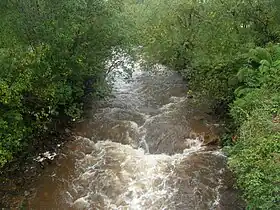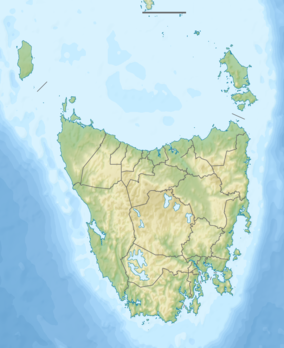| Queen | |
|---|---|
 | |
| Location | |
| Country | Australia |
| State | Tasmania |
| Region | West Coast |
| City | Queenstown |
| Physical characteristics | |
| Source | Mount Lyell, West Coast Range |
| • location | Gormanston |
| • coordinates | 42°0′56″S 145°34′46″E / 42.01556°S 145.57944°E |
| Source confluence | West Queen River and East Queen River |
| • location | Queenstown |
| • coordinates | 42°3′47″S 145°33′30″E / 42.06306°S 145.55833°E |
| • elevation | 164 m (538 ft) |
| Mouth | King River |
• coordinates | 42°09′23″S 145°31′42″E / 42.15639°S 145.52833°E |
• elevation | 60 m (200 ft) |
| Length | 13 km (8.1 mi) |
| [1] | |
The Queen River, part of the King River catchment, is a minor perennial river located in the West Coast region of Tasmania, Australia. It is notable for its high level of pollution caused by mining runoff which has led the river to be uninhabitable to life.
Course and features
The Queen River rises below Gormanston, sourced by runoff from the West Coast Range and in particular the peaks of Mount Lyell and Mount Owen. The two branches of the river, West Queen River and East Queen River, merge north of Queenstown and flow through the city and continue south, joined by one minor tributary before reaching its confluence with the King River.
The river valley is low-lying and narrow, and the subsequent fogs are notable in their effect, some created by smelter fumes in earlier years.[2][3][4]
In April 1906, a significant flooding occurred in Queenstown and the southern part of the town due to the river overflowing.[5][6] Subsequent recorded floods include in 1922,[7] 1937[8] and 1954.[9]
Tailings
For over 80 years the main carrier of Mount Lyell Mining and Railway Company mining residue, and the local sewage. It is estimated that 100 million tonnes (98,000,000 long tons) of tailings were disposed of into the Queen River.[10] This in turn flowed into the lower part of the King River, and then into a delta at the mouth of the river where it met Macquarie Harbour.[11][12] This 'acid mine drainage' is derived from water leaching through the exposed and oxidised sulfide rocks. When it was in operation, the fumes from the ore smelter produced acid rain which also leached minerals from the bare Queenstown hills.
Following the Mount Lyell Remediation and Research and Demonstration Program with the construction of tailings dams, and general reduction of waste into this river, the river flow is now rusty in colour rather than silvery grey as it was previously.
In 1992 the King River was dammed above the confluence with the Queen River to generate hydroelectric power at the Crotty Dam. This changed the flow regime in the King River, and affected the way tailings were transported through the river system. The tailings in the river greatly affect the water quality.
Since the closure of the mine in late 1995, and the construction of a tailings dam by the new operators, tailings no longer enter the river system. However, acid water continues to enter the river due to mine dewatering and run-off from the waste rock dumps. Without the buffering previously provided by the alkaline tailings, the acidity in the Queen and King rivers has increased, and dissolved metal concentrations have greatly increased-to levels completely inhospitable to life.
The river passes under and adjacent to the revitalised railway now known as the West Coast Wilderness Railway. South of Queenstown on the edge of the river is the early settlement of Lynchford where a gold mine and other mining activity supported a small community in the early days of the railway.[13]
In October 2018, TasDance dancers performed in the river, as part of The Unconformity festival, to create awareness of the effects mining pollution has on river systems. The performance was entitled "Junjeiri Bullun, Gurul Gaureima" (which translates to "Shallow Water, Deep Stories") and depicted native animals moving through the water while also exploring local indigenous history.[14]
See also

References
- ↑ "Map of Queen River, TAS". Bonzle Digital Atlas of Australia. 2015. Retrieved 30 June 2015.
- ↑ "FOG AT QUEENSTOWN". Launceston Examiner. Tas. 28 June 1899. p. 6. Retrieved 19 June 2015 – via National Library of Australia.
- ↑ "A DENSE FOG". The Examiner (DAILY ed.). Launceston, Tas. 7 July 1905. p. 6. Retrieved 19 June 2015 – via National Library of Australia.
- ↑ "QUEENSTOWN". Zeehan and Dundas Herald. Tas. 22 June 1914. p. 4. Retrieved 19 June 2015 – via National Library of Australia.
- ↑ "HEAVY FLOODS IN TASMANIA". The Register. Adelaide. 19 April 1906. p. 5. Retrieved 19 June 2015 – via National Library of Australia.
- ↑ "FLOODS IN TASMANIA". The Argus. No. 18, 644. Victoria, Australia. 19 April 1906. p. 5. Retrieved 6 November 2016 – via National Library of Australia.
- ↑ "Queen River". The Mercury. Vol. CXVIII, no. 17, 294. Tasmania, Australia. 10 March 1923. p. 7. Retrieved 6 November 2016 – via National Library of Australia.
- ↑ "Queenstown Council". The Advocate (Tasmania). Tasmania, Australia. 3 April 1937. p. 8. Retrieved 6 November 2016 – via National Library of Australia.
- ↑ "Close Watch on Rail Bridges". The Examiner (Tasmania). Vol. CXIII, no. 45. Tasmania, Australia. 4 May 1954. p. 3. Retrieved 6 November 2016 – via National Library of Australia.
- ↑ "Locals fear mine pollution turning Queen River into 'Pumpkin Soup Creek'". ABC News. 2 November 2017. Retrieved 30 September 2023.
- ↑ Davies, P.; Mitchell, N.; Barmuta, L. (1996). The impact of historical mining operations at Mount Lyell on the water quality and biological health of the King and Queen River catchments, western Tasmania. Canberra: Supervising Scientist Report 118, Supervising Scientist. ISBN 0-642-24317-4.
{{cite book}}:|work=ignored (help) - ↑ McQuade, C. V.; Johnston, J. F.; Innes, S. M. (23 August 1995). Review of historical literature and data on the sources and quality of effluent from the Mount Lyell lease site. Canberra: Supervising Scientist Report 104, Supervising Scientist. ISBN 0-642-24303-4.
{{cite book}}:|work=ignored (help) - ↑ Rae, Lou (2001). The Abt Railway and Railways of the Lyell region. Sandy Bay: Lou Rae. ISBN 0-9592098-7-5.
- ↑ (20 October 2018) Unconformity festival dancers make splash in Queenstown's toxic orange river, ABC News, Australian Broadcasting Corporation. Retrieved 20 October 2018.
Sources
- Blainey, Geoffrey (2000). The Peaks of Lyell (6th ed.). Hobart: St. David's Park Publishing. ISBN 0-7246-2265-9.
- Whitham, Charles (2003). Western Tasmania – A land of riches and beauty (Reprint 2003 ed.). Queenstown: Municipality of Queenstown.
